

Human Brain Project is a Study of the Effects of Drugs and the Human Brain. The Human Brain Project - Human Brain Project. Human Thought Controls Neurons in Brain. Neuroscience research involving epileptic patients with brain electrodes surgically implanted in their medial temporal lobes shows that patients learned to consciously control individual neurons deep in the brain with thoughts. Subjects learned to control mouse cursors, play video games and alter focus of digital images with their thoughts. Neurogenesis. Neurogenesis (birth of neurons) is the process by which neurons are generated from neural stem cells and progenitor cells.

Most active during pre-natal development, neurogenesis is responsible for populating the growing brain with neurons. Backwards signals appear to sensitize brain cells, rat study shows. Monday, March 18, 2013 During waking hours, electrical signals travel from dendrites—antenna-like projections at one end of the cell-- through the cell body.

From the cell body, they then travel the length of the axon, a single long projection at the other end of the cell. This electrical signal stimulates the release of chemicals at the end of the axon, which bind to dendrites on adjacent cells, stimulating these recipient cells to fire electrical signals, and so on. When groups of cells repeatedly fire in this way, the electrical signals increase in intensity. Dr. New neurons help us to remember fear. Fear burns memories into our brain, and new research by University of California, Berkeley, neuroscientists explains how.
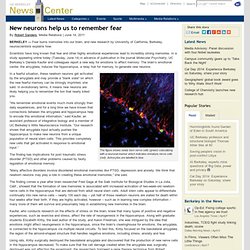
Scientists have long known that fear and other highly emotional experiences lead to incredibly strong memories. In a study appearing online today (Tuesday, June 14) in advance of publication in the journal Molecular Psychiatry, UC Berkeley’s Daniela Kaufer and colleagues report a new way for emotions to affect memory: The brain’s emotional center, the amygdala, induces the hippocampus, a relay hub for memory, to generate new neurons.
The figure shows newly born nerve cells (green) colocalizing with a neuronal marker which indicates immature nerve cells (red). Astrocytes are labelled in blue. In a fearful situation, these newborn neurons get activated by the amygdala and may provide a “blank slate” on which the new fearful memory can be strongly imprinted, she said.
Brainbow. Three brainbows of mouse neurons from Lichtman and Sanes, 2008 Brainbow is the process by which individual neurons in the brain can be distinguished from neighboring neurons using fluorescent proteins.
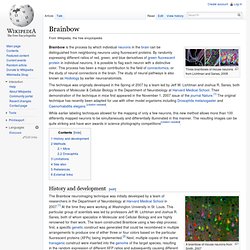
By randomly expressing different ratios of red, green, and blue derivatives of green fluorescent protein in individual neurons, it is possible to flag each neuron with a distinctive color. This process has been a major contribution to the field of connectomics, or the study of neural connections in the brain. The study of neural pathways is also known as Hodology by earlier neuroanatomists. The technique was originally developed in the Spring of 2007 by a team led by Jeff W. Harvard Researchers Unlocking Deep Mysteries Of Brain With Technicolor “Brainbow” Technique. First publised in Popular Science (February 25, 2011) by Rebecca Boyle..☛..In 2007, Harvard scientists figured out how to combine fluorescent proteins to create an entire color palette, and then used it to make mouse neurons glow so they could be traced through the brain.

The “Brainbow” technique has helped scientists follow neurons’ connections, which had been almost impossible to untangle. Fruit fly researchers have now done the same thing, producing a dual Brainbow of methods for making Drosophila neurons glow. It is much simpler and faster than staining individual neurons, another method for mapping brain connections. Simple mathematical computations underlie brain circuits. Optical mapping of functional inhibition by neurons MIT neuroscientists report that two major classes of brain cells repress neural activity in specific mathematical ways: One type subtracts from overall activation, while the other divides it.
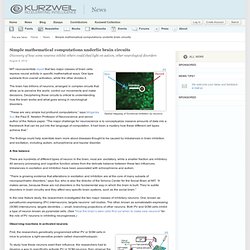
The brain has billions of neurons, arranged in complex circuits that allow us to perceive the world, control our movements and make decisions. Deciphering those circuits is critical to understanding how the brain works and what goes wrong in neurological disorders. “These are very simple but profound computations,” says Mriganka Sur, the Paul E. Newton Professor of Neuroscience and senior author of the Nature paper. The findings could help scientists learn more about diseases thought to be caused by imbalances in brain inhibition and excitation, including autism, schizophrenia and bipolar disorder. A fine balance. Blue Brain Project Accurately Predicts Connections Between Neurons. One of the greatest challenges in neuroscience is to identify the map of synaptic connections between neurons. A Robot Helps Listen In on Brain Cell Chatter. Erwin Neher and Bert Sakmann received the Nobel Prize in Physiology or Medicine in 1991 for their development of the patch-clamp technique, which records currents coursing through single ion channels in cells.

For neuroscientists, one form of this technique has become the gold standard for probing information about the goings-on inside a cell. It can not only track electrical activity but determine cell shape (through the use of dyes) and even which genes have switched on. The manual manipulation of the micropipette used for recording requires such delicate handling that only a small number of laboratories actually use the technique to study the living brain. A robot is now rushing to the rescue of legions of befuddled graduate students. Brain Explorer. Comparative Mammalian Brain Collections. Brain Explorer - Contr le neurologique - Neurotransmetteurs.
Alltop - Top Neuroscience News. Neuroscience News, Videos, Reviews and Gossip - io9. Center for Neuroeconomic Studies. Paul Thompson's Research Publications. UCLA researchers find that genes determine brain's processing speed Contact: Dr. Paul Thompson (310)206-2101 thompson@loni.ucla.edu or Mark Wheeler, UCLA Health Sciences Media Relations (310)794-2265 mwheeler@mednet.ucla.edu NPR Radio Story [Cached: Page 1][Page 2][Page 3][Front page] NPR Radio Interview (All Things Considered, March 20, 2009) [Audio, .mp3 format] NPR Radio Interview (All Things Considered, March 20, 2009) [Audio, .wav format] New Scientist Article (March 11, 2009) Journal of Neuroscience Article (Feb. 18, 2009) [.pdf].
Additional Press Coverage: Les bases neurologiques des “mèmes” : comment les idées deviennent-elles contagieuses. Par Rémi Sussan le 17/07/13 | 27 commentaires | 4,817 lectures | Impression Comment les idées deviennent-elles contagieuses ?
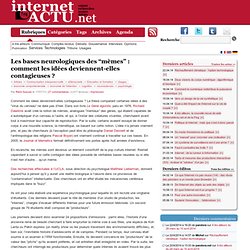
La thèse comparant certaines idées à des “virus du cerveau” ne date pas d’hier. Dans son livre Le Gène égoïste, paru en 1976, Richard Dawkins avait créé la notion de mèmes, analogues “mentaux” des gènes, qui étaient capables de s’autorépliquer d’un cerveau à l’autre, et qui, à l’instar des créatures vivantes, cherchaient avant tout à maximiser leur capacité de reproduction. Par la suite, certains avaient essayé de donner corps à une nouvelle science, la mémétique, se basant sur cette notion. L’idée n’a jamais vraiment pris, et peu de chercheurs (à l’exception peut être du philosophe Daniel Dennett et de l’anthropologue des religions Pascal Boyer) ont vraiment continué à travailler sur ces bases. En revanche, les mèmes sont devenus un élément constitutif de la pop culture internet. Neuroscience. Non-materialist neuroscience. Non-materialist neuroscience is one of the latest fronts in the war on science.
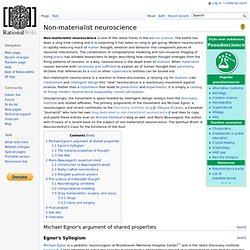
The battle has been a long time coming and it is surprising it has taken so long to get going. Modern neuroscience is rapidly reducing much of human thought, emotion and behavior into component pieces of neuronal interactions. The combination of computational modeling and non-invasive imaging of living brains has allowed researchers to begin describing how complex thought emerges from the firing patterns of neurons. The First Real Reason We Need To Sleep.
We know we need to sleep.

We know our brains and bodies work better after sleep. But what we didn't know, until now, was why. Scientists have just reported the first major mechanical reason our brains need to sleep — certain cleaning mechanisms in the brain work better when we shut the brain down. Hebbian theory. Hebbian theory is a theory in neuroscience which proposes an explanation for the adaptation of neurons in the brain during the learning process. It describes a basic mechanism for synaptic plasticity, where an increase in synaptic efficacy arises from the presynaptic cell's repeated and persistent stimulation of the postsynaptic cell. Introduced by Donald Hebb in his 1949 book The Organization of Behavior,[1] the theory is also called Hebb's rule, Hebb's postulate, and cell assembly theory.
How Does the Brain Retain Information? Researchers show that memories reside in specific brain cells. Our fond or fearful memories — that first kiss or a bump in the night — leave memory traces that we may conjure up in the remembrance of things past, complete with time, place and all the sensations of the experience. Neuroscientists call these traces memory engrams. But are engrams conceptual, or are they a physical network of neurons in the brain?
Le blog du cerveau à tous les niveaux – Niveau intermédiaire. Neuroscience For Kids.